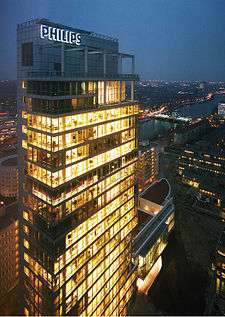Phoebus cartel
The Phoebus cartel is a cartel of, among others, Osram, Philips, and General Electric[1] from December 23, 1924 until 1939 that existed to control the manufacture and sale of light bulbs.[2]
The cartel is an important step in the history of the global economy because it engaged in large-scale planned obsolescence. It reduced competition in the light bulb industry for almost fifteen years, and has been accused of preventing technological advances that would have produced longer-lasting light bulbs. Phoebus was a Swiss corporation named "Phoebus S.A. Compagnie Industrielle pour le Développement de l'Éclairage".
Members
Osram, Philips, Tungsram, Associated Electrical Industries, ELIN, Compagnie des Lampes, International General Electric, and the GE Overseas Group were members of the Phoebus cartel,[3] holding shares in the Swiss corporation proportional to their lamp sales.
In 1921 a precursor organisation was founded by Osram, the "Internationale Glühlampen Preisvereinigung". When Philips and other manufacturers were entering the American market, General Electric reacted by setting up the "International General Electric Company" in Paris. Both organisations co-ordinated the trading of patents and market penetration. Increasing international competition led to negotiations between all the major companies to control and restrict their respective activities in order not to interfere in each other's spheres.[4][5]
Purpose
The cartel was a convenient way to lower costs and worked to standardise the life expectancy of light bulbs at 1,000 hours, while at the same time raising prices without fear of competition. Members' bulbs were regularly tested and fines were levied for bulbs that lasted more than 1,000 hours. A 1929 table lists exactly how many Swiss francs had to be paid, depending on the exceeding hours of lifetime.[6] This was not public knowledge at the time, and the cartel could point to standardization of light bulbs as an alternative rationale for the organization.
Some engineers say that 1,000 hours was a reasonable optimum life expectancy for most bulbs, and that a longer lifetime could be obtained only at the expense of efficiency, since progressively more heat and less light is obtained, resulting in wasted electricity.[7] Long-life incandescent bulbs are available today which last up to 2,500 hours; the trade off is that long-life bulbs are less energy efficient and produce less light per watt.[8]
The Phoebus cartel divided the world’s lamp markets into three categories:
- home territories, the home country of individual manufacturers
- British overseas territories, under control of Associated Electrical Industries, Osram, Philips, and Tungsram
- common territory, the rest of the world
Demise
In the late 1920s a Swedish-Danish-Norwegian union of companies (the North European Luma Co-op Society) began planning an independent manufacturing center. Economic and legal threats by Phoebus did not achieve the desired effect, and in 1931 the Scandinavians produced and sold lamps at a considerably lower price than Phoebus.[9]
The original Phoebus agreement was intended to expire in 1955;[10] however, World War II greatly disrupted the operation of the cartel.
References
- ↑ Metze, Marcel "Anton Philips (1874-1951). They will know who they're dealing with", Uitgeverij Balans, Amsterdam, 2004, ISBN 90 5018 612 2 (Summary).
- ↑ http://www.newyorker.com/business/currency/the-l-e-d-quandary-why-theres-no-such-thing-as-built-to-last
- ↑ "Corporations: A Very Tough Baby". Time Magazine. 1945-07-23. Retrieved 2009-04-11.
- ↑ Jürgen Bönig (1993). Die Einführung von Fliessbandarbeit in Deutschland bis 1933 (in German). LIT Verlag Münster. p. 277. ISBN 3894731117.
- ↑ Markus Krajewski (24 September 2014). "The Great Lightbulb Conspiracy". IEEE Spectrum.
- ↑ Peretti, Jacques (July 2014). "The Men Who Made Us Spend, Episode 1". BBC.
- ↑ Hehkulampussa ja ledissä sama ongelma: lämpö, Suomen Kuvalehti 13.10.2011, an interview of research scientist, D.Sc. Eino Tetri, Leader of the Light Sources and Energy Group in Aalto University
- ↑ Incandescent, LED, Fluorescent, Compact Fluorescent and Halogen Bulbs.
- ↑ A history of pre-war lightbulb manufacture, 14-04-2015,
- ↑ Krajewski, Markus (24 September 2014). "The Great Lightbulb Conspiracy". IEEE Spectrum. Retrieved 12 October 2014.
Further reading
- Wells, Wyatt C. (2002). Antitrust and the Formation of the Postwar World. New York: Columbia University Press. ISBN 0-231-12398-1.
External links
- Patrick Gaughen "Structural Inefficiency in the Early Twentieth Century: Studies in the Aluminum and Incandescent Lamp Markets" Social Science 610, December, 1998, 36 pp.
- U K Monopolies Commission "Report on the Supply of Electric Lamps", His Majesty's Stationery Office, London, October 1951, v + 199 pp.
- Markus Krajewski "The Great Lightbulb Conspiracy" IEEE Spectrum, September, 2014.
